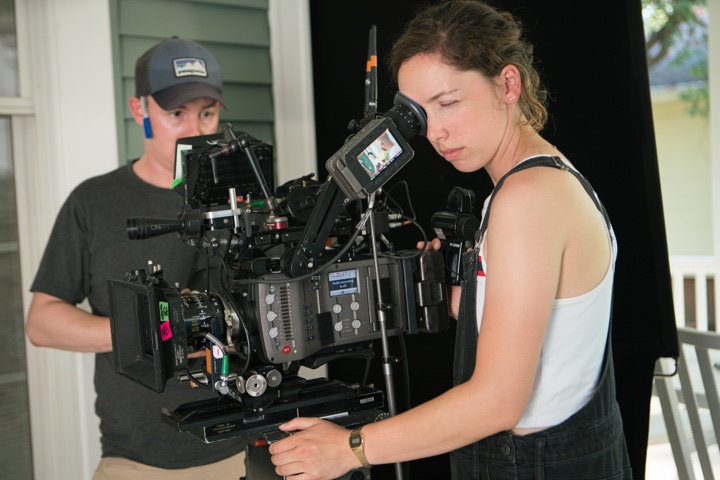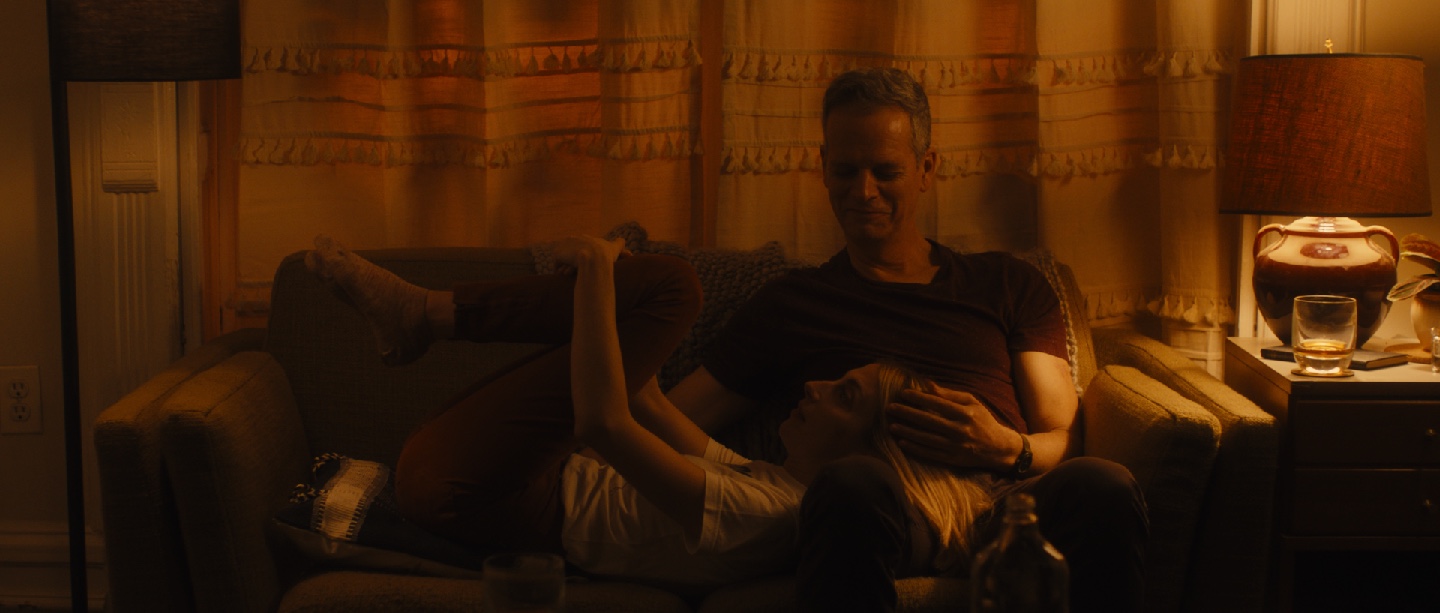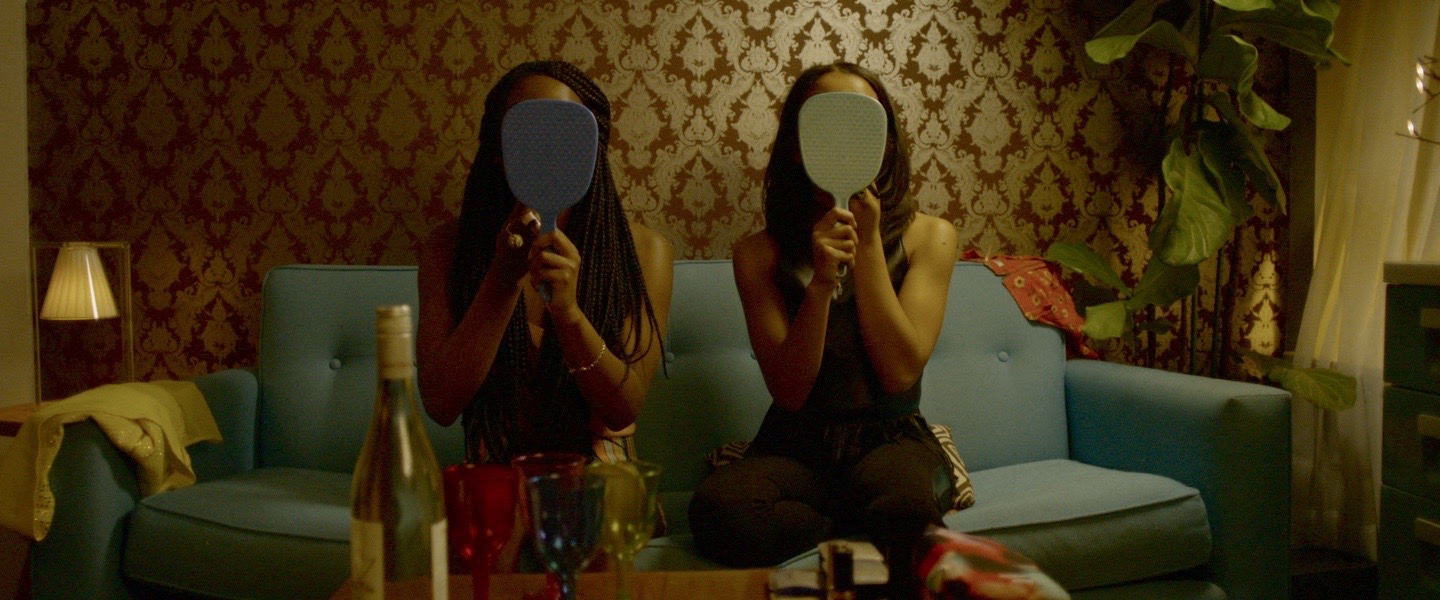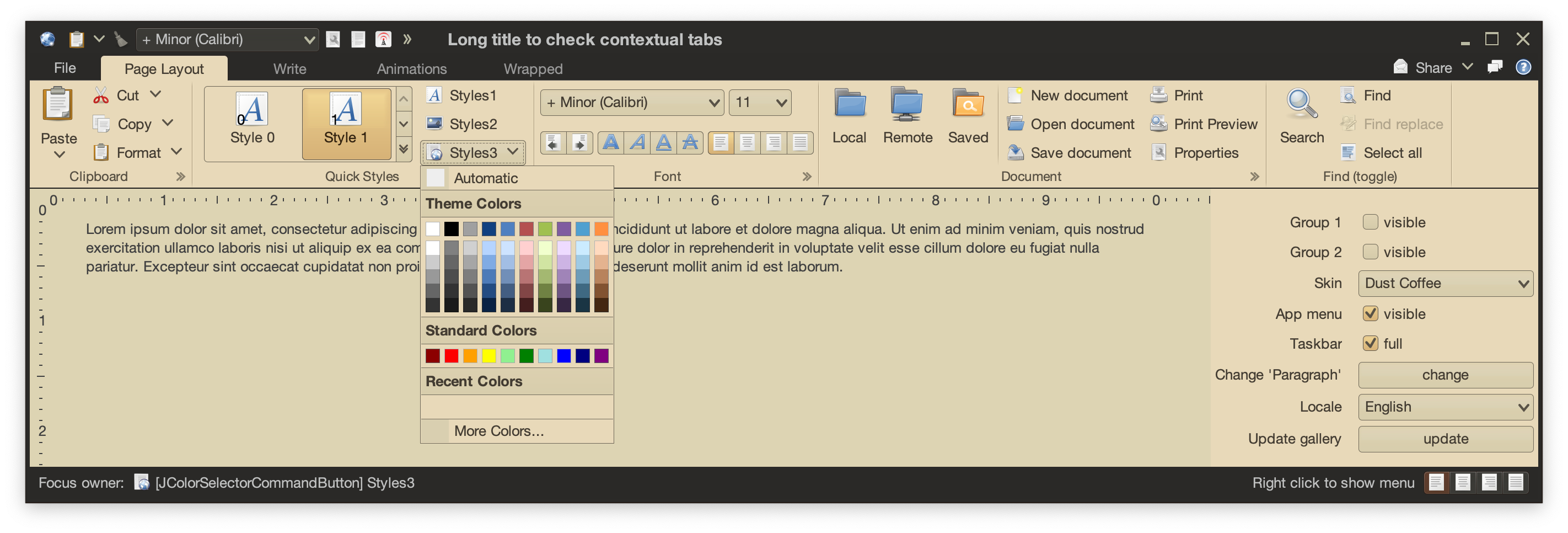Continuing the ongoing series of interviews with creative artists working on various aspects of movie and TV productions, it is my pleasure to welcome Maria Rusche. In this interview she talks about teaching cinematography to the next generation of storytellers (spoiler alert, they love film), keeping up with the technical advances, affecting social change through her stories, and the future of storytelling in post-Corona world. Around these topics and more, Maria dives into her work on the upcoming “Dating and New York”.

Maria Rusche behind the scenes.
Kirill: Please tell us about yourself and the path that took you to where you are today.
Maria: When I went to film school, I thought that maybe I wanted to be an editor. I have a cousin who worked as an editor on big comedies, and I thought that that was the part of the storytelling that I wanted to be a part of – crafting of the arc. But then I got into film school and started to learn more about how movies are actually made. I figured out what the job of the cinematographer is, which is to work with the director and the production designer to create a visual language to tell the story, and create this visual world – but also work with a team of people to actualize that vision.
That role really made sense to me, as someone who grew up playing a lot of team sports. It’s a leadership position, but really it’s about working with and delegating to a team, and collaborating with the team. That was an area of the storytelling that I fit into really well. So I got into cinematography when I was in school, and I never looked back.
Kirill: Do you think this field does not work well for people who don’t collaborate well with others? Perhaps people that have strong ideas that they are not willing to compromise on?
Maria: There can be a bit of a stereotype of this auteur who rules with an iron fist, and has their vision and they won’t compromise. But I’m not sure how true that actually is.
The best directors and cinematographers can understand what the vision is that they’re trying to achieve, and they’re able to encourage the people around them to contribute their own ideas. And then they’re able to filter what works well for the project and what might not work well so that there’s a cohesiveness across the project. There’s absolutely no way that one person can execute everything, and I mean that literally. They’re not moving the lights around, they’re not moving the camera themselves. They need people to work with them, and if you can’t work with the team, I’m not sure how great of a product you can ultimately make.

Cinematography of “Milkwater” by Maria Rusche.
Kirill: There’s so much great storytelling that has been happening in the last few years, especially on streaming services. Do you feel that there’s more space for storytellers of different backgrounds to have their voices heard?
Maria: I’m definitely excited by the democratization of voices getting opportunities. There’s a lot of streaming services that are starting to produce content, or at least give a platform for a wider variety of content to be seen. Some people worry that it’s too much content, but I think it’s still true that the good stuff floats to the top. We are seeing a wider variety of storytelling opportunities for people who didn’t traditionally get opportunities, and by opportunities I mean financing, compared to a few years ago.
I feel that there’s still a gatekeeping aspect of it. It’s still these streaming services or production companies that are choosing who gets to tell those stories, and what stories they deem are authentic enough or palatable enough. The “diverse” stories that we’re getting are still the ones that streaming services deem palatable or appealing to an audience. I would say I’m excited, but with that caveat.
Kirill: Is there a space for crowd-funded initiatives that are so popular in the gaming world, or in the world of gadgets – on platform like Kickstarter, or are these productions a little bit too expensive for that?
Maria: It’s a little bit expensive. You are seeing some crowd-funded independent movies. You can make a movie on a smaller budget compared to 20 years ago, and maybe those movies are serving as a way for a new director to get their foot in the door and get a little bit of attention. But most of those independent movies still end up being made by people with some connections to financiers in some way, or at least an ability to call a few people and scrape together a couple hundred thousand dollars to make their movie. That model doesn’t really help those who don’t have any access to wealthy donors.
I have not seen a true crowd-funded movie from someone who has gotten a hundred thousand people to give two dollars each. There’s still some issues there.

Cinematography of “Might” by Maria Rusche.
Continue reading »

It gives me great pleasure to announce the sixth major release of Radiance. Let’s get to what’s been fixed, and what’s been added. First, I’m going to use emojis to mark different parts of it like this:
💔 marks an incompatible API / binary change
🎁 marks new features
🔧 marks bug fixes and general improvements
Dependencies for core libraries
- Gradle from 6.6.1 to 7.1
- Kotlin from 1.4.10 to 1.5.10
- Kotlin coroutines from 1.3.9 to 1.5.0
Substance
Flamingo
- 🎁 Add support for keyboard accelerators on ribbon commands
- 🔧 Fix ribbon application menu border color on skin switch
- 🔧 Fix exception on skin switch when the ribbon application menu is not shown
- 🔧 Fix for various visuals on multi-monitor setup with different screen densities
- 🔧 Fix even-odd coloring of command button panel groups
- 💔 Tweak implementation of
FIT_TO_ICON command button layout manager
Trident
- 💔 Rename
TridentConfig to TridentCortex
As with the earlier release 3.5.0, this release has mostly been focused on stabilizing and improving the overall API surface of the various Radiance modules. There’s still a long road ahead to continue exploring the never-ending depths of what it takes to write elegant and high-performing desktop applications in Swing. If you’re in the business of writing just such apps, I’d love for you to take this Radiance release for a spin. Click here to get the instructions on how to add Radiance to your builds. And don’t forget that all of the modules require Java 9 to build and run.
Adding a couple more to the “just five years out horizon” list of wonderfully unrealistic promises in mass transportation sector, courtesy of this tweet.
First off, back in 2016 the breathless “Airbus Expects Flying Taxis by 2021“:
Airbus have announced the unthinkable and stated their desire to introduce flying taxis. As crazy as it might sound, the idea has been put forward by a subdivision of the aerospace and defense corporation named A3. They are responsible for creating innovative ideas and, based on this latest development, they’re certainly delivering.
[…]
Their latest design would be completely autonomous, requiring no driver and hailed using a traditional smartphone app. Customers would open the app and order the flying taxi to their front door before being whisked off to their next destination without the need to tackle rush hour traffic.
[…]
Given the number of ideas that don’t take off, it would be easy to dismiss this as just another marketing gimmick. It is not unknown for companies to announce far fetched ideas to drum up publicity before quietly removing all funding. With this project, however, the first notable milestone is very much in sight.
Certainly delivering. Very much in sight. Yes indeed.
The second one, a bit later in 2017 (with 2021 still being the target year) from “A New Hyperloop System is Slated to Connect European Cities by 2021“:
It looks like the Netherlands would soon join Slovakia, and the Czech Republic as the next European country to have a Hyperloop. A Dutch team from the Technical University of Delft (TU Delft) won this year’s edition of SpaceX’s competition to develop this next generation, super-fast transport technology, and they’re already setting up a full-scale testing center.
[…]
The initial round of testing has already received $675,000 in funding. More would be needed for a high-speed test line by 2019 to accomplish their goal of setting up a Hyperloop system between Amsterdam and Paris by 2021.
Meanwhile, the best Hyperloop has been able to do so far was a 15-second [!!!] ride late last year in Las Vegas. Of course, the five-year out horizon is still very much alive.
September 2016, from the co-founder of Lyft (emphasis on the timeline mine):
Last January, Lyft announced a partnership with General Motors to launch an on-demand network of autonomous vehicles. If you live in San Francisco or Phoenix, you may have seen these cars on the road, and within five years a fully autonomous fleet of cars will provide the majority of Lyft rides across the country.
December 2020, Uber exiting the much-hyped business of replacing human drivers with self-driving cars:
Uber Technologies Inc. sold its self-driving-car unit to a Silicon Valley competitor, Aurora Innovation Inc., in the latest business exit by the ride-hailing company as it aims to deliver on a promise to shareholders to become profitable.
April 2021, right around the projected mark of 2021 being the year where “a fully autonomous fleets of cars will provide the majority of Lyft rides across the country”, Lyft offloading their (failed) self-driving car division to Toyota:
Lyft, Inc. (LYFT) announced today that the company has signed an agreement with Woven Planet Holdings, Inc., (“Woven Planet”), a subsidiary of Toyota Motor Corporation, for the acquisition of Lyft’s self-driving vehicle division, Level 5
As I said just two years ago, self-driving cars are highly unlikely to happen within the next 20 years, with the following disclaimer:
By self-driving cars I mean the combination of technology and legislature that would give me the option, owned, leased or on-demand, to have a vehicle for myself and my family to get me from point A to point B at my time of choosing. The only mandatory condition is that it would not require me to pay any attention to what is happening during the trip.
If I am required – by technology or by law – to be able to take over the control of the vehicle at any point in time, that is not a self-driving car in my world. If the technology is only available on specific roads (highways, for example) or under very specific weather conditions, that is also not a self-driving car in my world.
I still stand by my prediction. If anything, I’ll make you another deal. As long as the loudest voices in the business of selling this pipe dream keep on saying that self-driving cars will be here within 5 years, I’ll keep on saying that self-driving cars will not happen in at least 20 years. Let’s see who wins this little game.
![]()
![]()
![]()